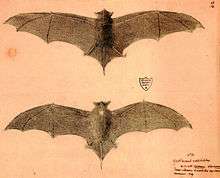Natal free-tailed bat
The Natal free-tailed bat (Mormopterus acetabulosus) is a species of bat in the family Molossidae, the free-tailed bats. It is native to the islands of Mauritius and Réunion. It is known from fewer than five locations in its range, but it is common at a few sites. It roosts in caves, and it is considered to be an endangered species due to disturbance of its cave habitat.[1]
| Natal free-tailed bat | |
|---|---|
 | |
| Type illustration by Paul Jossigny from 1770 | |
| Scientific classification | |
| Kingdom: | Animalia |
| Phylum: | Chordata |
| Class: | Mammalia |
| Order: | Chiroptera |
| Family: | Molossidae |
| Genus: | Mormopterus |
| Subgenus: | Mormopterus |
| Species: | M. acetabulosus |
| Binomial name | |
| Mormopterus acetabulosus Hermann, 1804 | |
| Synonyms | |
| |
Taxonomy and etymology
It was described as a new species in 1804 by French naturalist Johann Hermann. Hermann placed it in the genus Vespertilio.[2] In 2008, the Natal free-tailed bat was split into two taxa with the description of a new species, Mormopterus francoismoutoui. The species is called the "Natal" free-tailed bat because of another species Hermann described, Dysopes natalensis, named after the Natal Province of South Africa. Dysopes natalensis was later synonymized with the Natal free-tailed bat.[3] Its species name "acetabulosus" is Latin for saucer-shaped.[4]
Description
The Natal free-tailed bat is a very small species of bat. Its upper lip is very wrinkled. Its ears are small and connected in the back by a thin interaural membrane. Males have a sebaceous gland, as with some other free-tailed bats, but they do not have an interaural crest. Its dental formula is 1.1.1.33.1.2.3 for a total of 30 teeth.[2]
Range and habitat
It is endemic to Mauritius. There is one "doubtful" record from Madagascar and two records from South Africa which may be vagrants.[1]
Conservation
As of 2017, it is listed as endangered by the IUCN. From 1999–2017, its population likely declined by more than 80%. Its caves are being disturbed for tourism.[1]
References
- Bergmans, W.; Hutson, A.M.; Oleksy, R.; Taylor, F. (2017). "Mormopterus acetabulosus". IUCN Red List of Threatened Species. 2017: e.T71733227A22085232.
- Kingdon, J.; Happold, D.; Butynski, T.; Hoffmann, M.; Happold, M.; Kalina, J. (2013). Mammals of Africa. 4. A&C Black. p. 473–474. ISBN 9781408189962.
- Goodman, S. M; Van Vuuren, B. Jansen; Ratrimomanarivo, F; Probst, J-M; Bowie, R. C K (2008). "Specific status of populations in the Mascarene Islands referred to Mormopterus acetabulosus (Chiroptera: Molossidae), with description of a new species". Journal of Mammalogy. 89 (5): 1316–1327. doi:10.1644/07-MAMM-A-232.1.
- Gledhill, D. (2008). The names of plants. Cambridge University Press. p. 34. ISBN 0521866456.
